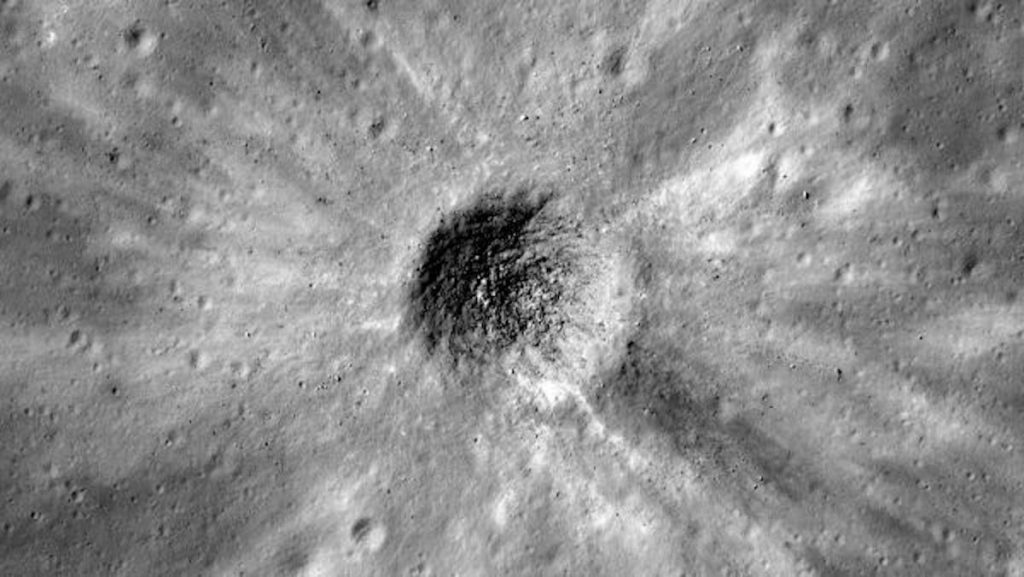
How many space rocks hit the moon every year? (Image Credit: Space.com)

When NASA sent humans to the moon in 1969, one of the many hazards the agency had to anticipate was space rocks penetrating astronauts’ spacesuits or equipment. Unlike Earth, which has a protective atmosphere in which meteoroids usually disintegrate, the moon is vulnerable to whatever rocks, or even specks, are whizzing around in space.
Thankfully, the astronauts weren’t in too much danger, according to Bill Cooke, head of NASA’s Meteoroid Environment Office at NASA’s Marshall Space Flight Center in Alabama. “The odds of an astronaut being hit by a millimeter-sized object is like 1 in 1 million per hour per person,” Cooke told Live Science. (A millimeter is the largest a meteoroid has to be to penetrate an astronaut’s spacesuit.)
NASA is preparing to send humans back to the moon by 2025 and someday establish a base either orbiting the moon or on its surface, so it’s more important than ever to understand the frequency with which our natural satellite experiences an impact.
Related: How many humans could the moon support?
So how many objects hit the moon every day? What about every year?
The answer depends on the size of the object, Cooke said. NASA’s Meteoroid Environment Office studies the space environment around Earth and the moon to understand the flux of meteoroids (space rocks ranging in size from dust to small asteroids about 3 feet, or 1 meter, across), so Cooke is very familiar with what’s hitting the moon every day.
For impactors smaller than a millimeter, the number cannot be precisely quantified, but Cooke estimates that 11 to 1,100 tons (10 to 1,000 metric tons) — the mass of about 5.5 cars — of dust collide with the moon per day. For larger rocks, the estimates are clearer.
“There are about 100 pingpong-ball-sized meteoroids hitting the moon per day,” Cooke said. That adds up to roughly 33,000 meteoroids per year. Despite their small size, each of these pingpong-ball-size rocks impacts the surface with the force of 7 pounds (3.2 kilograms) of dynamite.
Larger meteoroids hit the moon, too, but less often. Cooke estimates that larger meteoroids, such as ones 8 feet (2.5 meters) across, slam into the moon about every four years. Those objects hit the moon with the force of a kiloton, or 1,000 tons (900 metric tons) of TNT. The moon is about 4.5 billion years old, so it’s no wonder its surface is pockmarked with all kinds of craters from these impacts.
Scientists study lunar impacts in a couple of different ways. From Earth’s surface, scientists point telescopes toward the moon to observe impacts. Meteoroids can hit the surface at speeds of 45,000 to 160,000 mph (20 to 72 kilometers per second), according to NASA; the impact produces a flash of light that can be observed from Earth.
Scientists can also use spacecraft orbiting the moon itself, such as NASA’s Lunar Reconnaissance Orbiter (LRO), to observe the craters left behind by impacts. Because meteoroids move so fast, even an 11-pound (5 kilograms) meteoroid can leave behind a crater 30 feet (9 m) across and hurl 165,000 pounds (75,000 kg) of lunar soil and rocks from the moon’s surface, according to NASA. The LRO can easily spot these craters after they form.
Although the moon experiences many impacts per year, that doesn’t necessarily preclude a human presence. Considering the moon’s surface area is about 14.6 million square miles (38 million square kilometers), “if you pick a square kilometer patch of ground, it will be hit by one of those pingpong-sized meteoroids once every thousand years or so,” Cooke said.
So, the odds are good for our future lunar explorers and their spacecraft.





